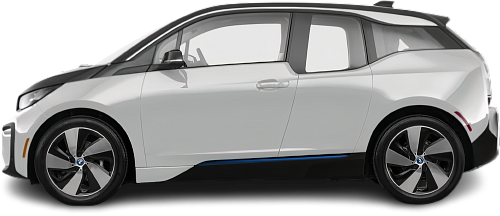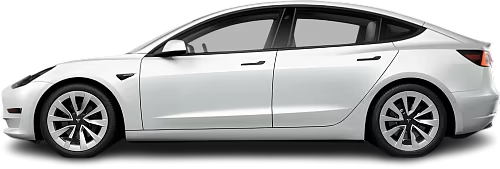Global EV Comparison: BMW i3 BEV 60 Ah vs Tesla Model 3 Mid Range
Struggling to Decide? Let AI Help!
Your AI Summary Is Ready!
General Info
Since both vehicles have been discontinued, they are now only available on the used car market. You can get the BMW i3 BEV 60 Ah (2013-2017) for as low as €11200, while the Tesla Model 3 Mid Range (2018-2020) was never offered for sale in Europe.
The BMW i3 BEV 60 Ah (2013-2017) is a Hatchback, whereas the Tesla Model 3 Mid Range (2018-2020) is a Sedan.
| Property | BMW i3 BEV 60 Ah | Tesla Model 3 Mid Range |
|---|---|---|
| Years of Production | 2013-2017 | 2018-2020 |
| Current Status | Discontinued | Discontinued |
| Country of Manufacture | Germany | USA |
| Body Style | Hatchback | Sedan |
| Market Availability | EU, USA | USA |
| Price Europe (Used) | €11200 | - Price Europe (Used) |
| GCC Score | 4.9 | 6 |
Range and Efficiency
While the Tesla Model 3 Mid Range (2018-2020) offers a longer real-world range and a bigger battery, it is less energy-efficient than the BMW i3 BEV 60 Ah (2013-2017).
| Property | BMW i3 BEV 60 Ah | Tesla Model 3 Mid Range |
|---|---|---|
| Range (EPA) | 130 km | 425 km |
| Range (WLTP) | - Range (WLTP) | 457 km |
| Range (GCC) | 133 km | 396 km |
| Battery Capacity (Nominal) | 21.6 kWh | 65 kWh |
| Battery Capacity (Usable) | 18.8 kWh | 62 kWh |
| Efficiency per 100 km | 14.1 kWh/100 km | 15.7 kWh/100 km |
| Efficiency per kWh | 7.07 km/kWh | 6.39 km/kWh |
| Range and Efficiency Score | 5.8 | 7.6 |
Charging
Both vehicles utilize a standard 400-volt architecture.
The Tesla Model 3 Mid Range (2018-2020) offers faster charging speeds at DC stations, reaching up to 200 kW, while the BMW i3 BEV 60 Ah (2013-2017) maxes out at 50 kW.
The Tesla Model 3 Mid Range (2018-2020) features a more powerful on-board charger, supporting a maximum AC charging power of 7.7 kW, whereas the BMW i3 BEV 60 Ah (2013-2017) is limited to 7.4 kW.
| Property | BMW i3 BEV 60 Ah | Tesla Model 3 Mid Range |
|---|---|---|
| Max Charging Power (AC) | 7.4 kW | 7.7 kW |
| Max Charging Power (DC) | 50 kW | 200 kW |
| Architecture | 400 V | 400 V |
| Charge Port | CCS Type 2 | Tesla (NACS) |
| Charging Score | 3.8 | 5.5 |
Performance
Both vehicles are rear-wheel drive.
The Tesla Model 3 Mid Range (2018-2020) boasts greater motor power and accelerates faster from 0 to 100 km/h.
| Property | BMW i3 BEV 60 Ah | Tesla Model 3 Mid Range |
|---|---|---|
| Drive Type | RWD | RWD |
| Motor Type | PMSM | PMSM |
| Motor Power (kW) | 125 kW | 202 kW |
| Motor Power (hp) | 168 hp | 271 hp |
| Motor Torque | 250 Nm | 404 Nm |
| 0-100 km/h | 7.2 s | 5.5 s |
| Top Speed | 150 km/h | 225 km/h |
| Performance Score | 3.2 | 5 |
Dimensions
The Tesla Model 3 Mid Range (2018-2020) is longer and wider, but the BMW i3 BEV 60 Ah (2013-2017) is taller.
The Tesla Model 3 Mid Range (2018-2020) boasts a more extended wheelbase.
| Property | BMW i3 BEV 60 Ah | Tesla Model 3 Mid Range |
|---|---|---|
| Length | 3999 mm | 4695 mm |
| Width (with Mirrors) | 2039 mm | 2088 mm |
| Width (w/o Mirrors) | 1775 mm | 1850 mm |
| Height | 1578 mm | 1445 mm |
| Wheelbase | 2570 mm | 2875 mm |
Cargo and Towing
The Tesla Model 3 Mid Range (2018-2020) provides more cargo capacity, featuring both a larger trunk and more space with the rear seats folded.
A frunk (front trunk) is available in the Tesla Model 3 Mid Range (2018-2020), but the BMW i3 BEV 60 Ah (2013-2017) doesn’t have one.
The Tesla Model 3 Mid Range (2018-2020) has a towing capacity of up to 910 kg, whereas the BMW i3 BEV 60 Ah (2013-2017) is not officially rated for towing in the EU.
| Property | BMW i3 BEV 60 Ah | Tesla Model 3 Mid Range |
|---|---|---|
| Number of Seats | 4 | 5 |
| Curb Weight | 1270 kg | 1672 kg |
| Cargo Volume (Trunk) | 260 l | 561 l |
| Cargo Volume (Max) | 1100 l | 1235 l |
| Cargo Volume (Frunk) | - Cargo Volume (Frunk) | 88 l |
| Towing Capacity | - Towing Capacity | 910 kg |
| Cargo and Towing Score | 4.2 | 5.1 |




